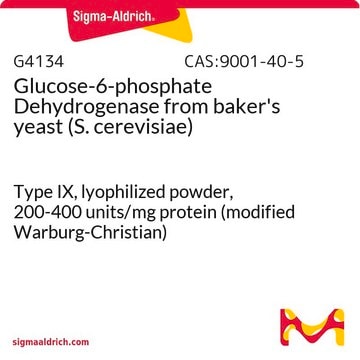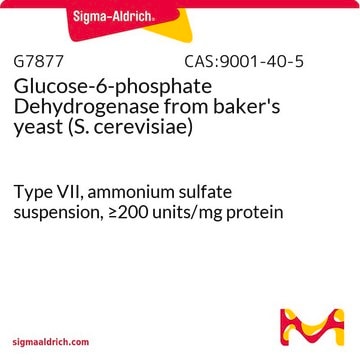Products may be shipped at a different temperature than the recommended long-term storage temperature. If the product quality is sensitive to short-term exposure to conditions other than the recommended long-term storage, it will be shipped on wet or dry-ice. If the product quality is NOT affected by short-term exposure to conditions other than the recommended long-term storage, it will be shipped at ambient temperature. As shipping routes are configured for minimum transit times, shipping at ambient temperature helps control shipping costs for our customers. For more information, please refer to the Storage and Transport Conditions document: https://www.sigmaaldrich.com/deepweb/assets/sigmaaldrich/marketing/global/documents/316/622/storage-transport-conditions-mk.pdf
G7879
D-Glucose 6-phosphate sodium salt
≥98% (HPLC)
Sinonimo/i:
D(+)-Glucopyranose 6-phosphate sodium salt, G-6-P Na, Robison ester
Scegli un formato
Scegli un formato
About This Item
Prodotti consigliati
Origine biologica
synthetic (organic)
Livello qualitativo
Saggio
≥98% (HPLC)
Stato
crystalline
tecniche
HPLC: suitable
Colore
white
Intervallo di pH utile
4.0-5.0
Punto di fusione
204 °C (dec.) (lit.)
Solubilità
water: 50 mg/mL, clear, colorless to very faintly yellow
Cationi in tracce
Na: 6.1-10.2% (anhydrous)
Temperatura di conservazione
room temp
Stringa SMILE
[Na+].O[C@@H]1O[C@H](COP(O)([O-])=O)[C@@H](O)[C@H](O)[C@H]1O
InChI
1S/C6H13O9P.Na/c7-3-2(1-14-16(11,12)13)15-6(10)5(9)4(3)8;/h2-10H,1H2,(H2,11,12,13);/q;+1/p-1/t2-,3-,4+,5-,6-;/m1./s1
ZALKNDISPIVVKC-WYRLRVFGSA-M
Cerchi prodotti simili? Visita Guida al confronto tra prodotti
Categorie correlate
Applicazioni
Azioni biochim/fisiol
Avvertenza
Altre note
Codice della classe di stoccaggio
11 - Combustible Solids
Classe di pericolosità dell'acqua (WGK)
WGK 3
Punto d’infiammabilità (°F)
Not applicable
Punto d’infiammabilità (°C)
Not applicable
Dispositivi di protezione individuale
Eyeshields, Gloves, type N95 (US)
Scegli una delle versioni più recenti:
Certificati d'analisi (COA)
Non trovi la versione di tuo interesse?
Se hai bisogno di una versione specifica, puoi cercare il certificato tramite il numero di lotto.
Possiedi già questo prodotto?
I documenti relativi ai prodotti acquistati recentemente sono disponibili nell’Archivio dei documenti.
I clienti hanno visto anche
Articoli
Warburg effect enhances glucose to lactate conversion in tumor cells, regardless of oxygen levels; impacting cancer metabolism since 1924.
Protocolli
To measure glucose-6-phosphatase activity, the Taussky-Shorr method is used. This method is a spectrophotometric stop-rate determination assay that is measured at 660 nm.
To measure glucose-6-phosphate dehydrogenase activity, beta-nicotinamide adenine dinucleotide phosphate is used in a spectrophotometric rate determination assay at 340 nm.
-
How is shipping temperature determined? And how is it related to the product storage temperature?
1 answer-
Helpful?
-
-
How can I determine the shelf life / expiration / retest date of this product?
1 answer-
If this product has an expiration or retest date, it will be shown on the Certificate of Analysis (COA, CofA). If there is no retest or expiration date listed on the product's COA, we do not have suitable stability data to determine a shelf life. For these products, the only date on the COA will be the release date; a retest, expiration, or use-by-date will not be displayed.
For all products, we recommend handling per defined conditions as printed in our product literature and website product descriptions. We recommend that products should be routinely inspected by customers to ensure they perform as expected.
For products without retest or expiration dates, our standard warranty of 1 year from the date of shipment is applicable.
For more information, please refer to the Product Dating Information document: https://www.sigmaaldrich.com/deepweb/assets/sigmaaldrich/marketing/global/documents/449/386/product-dating-information-mk.pdfHelpful?
-
-
May I know what is the recommended storage condition for the reconstituted working solution and the estimated shelf life for both the stock and the working solution?
1 answer-
Unfortunately, the stability of the material in solution at the working concentration has not been determined. However, similar product 346764, α-D-Glucose-6-phosphate monosodium salt, states that aqueous stock solutions are stable for up to 6 weeks at -20°C.
Helpful?
-
Active Filters
Il team dei nostri ricercatori vanta grande esperienza in tutte le aree della ricerca quali Life Science, scienza dei materiali, sintesi chimica, cromatografia, discipline analitiche, ecc..
Contatta l'Assistenza Tecnica.









